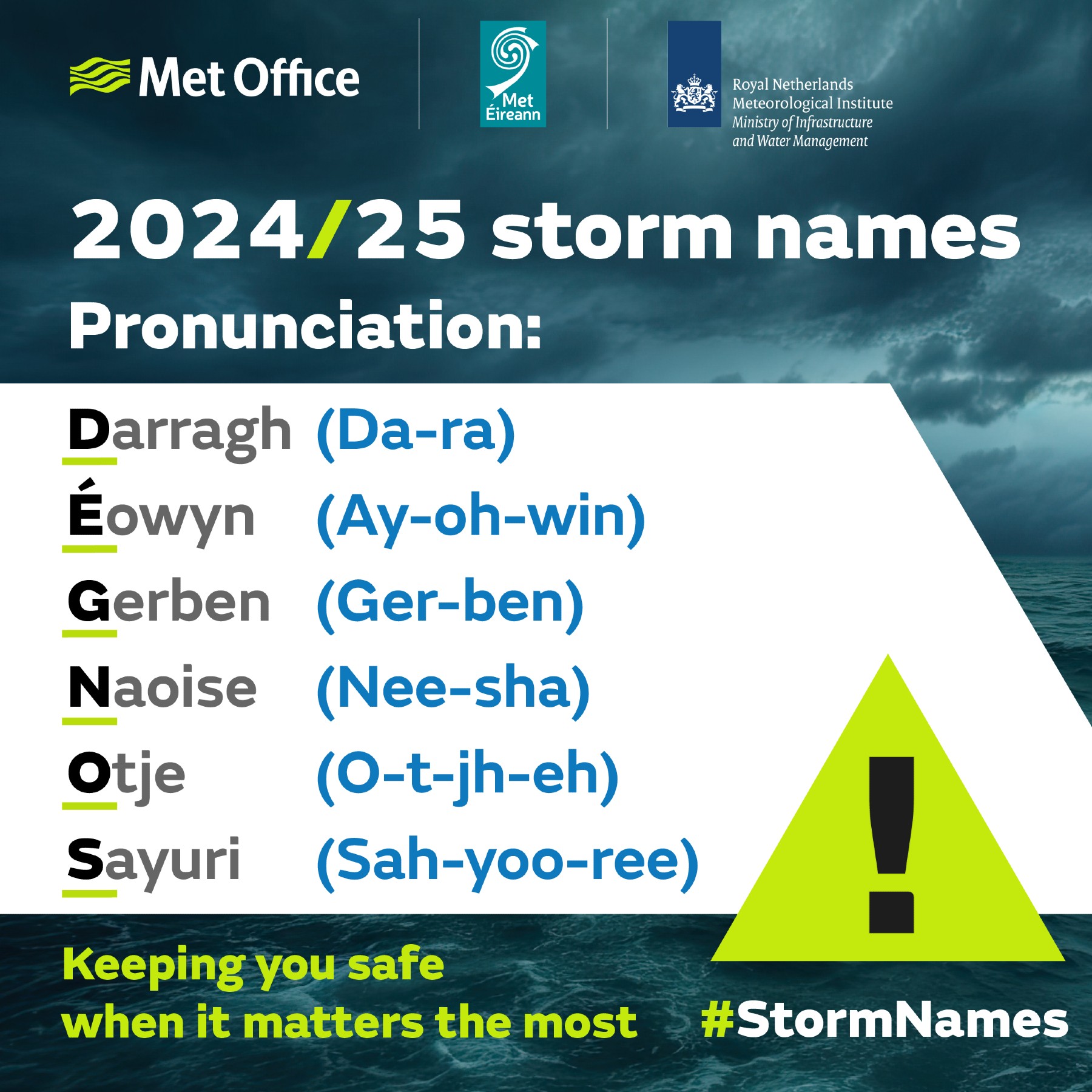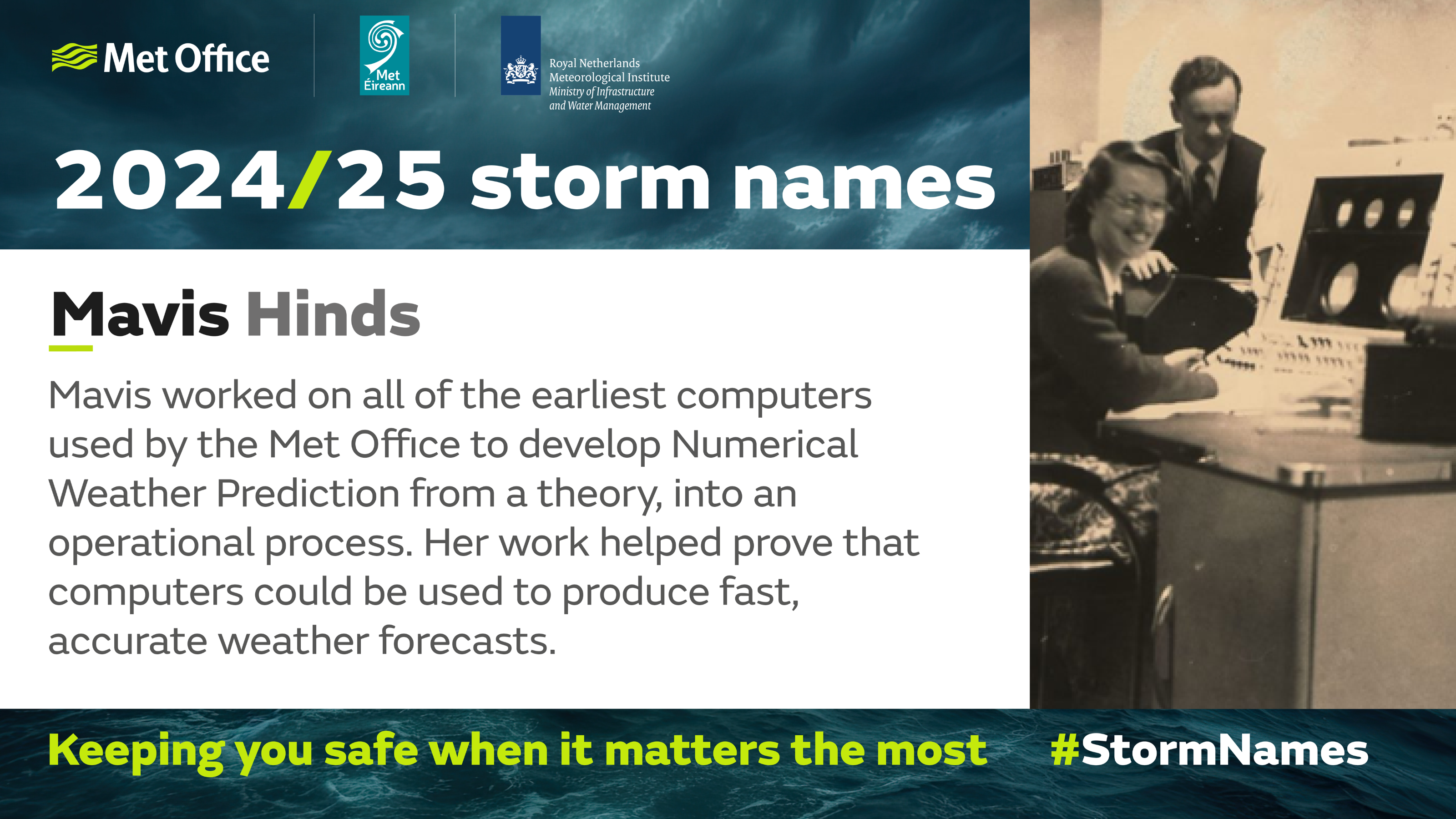Historic Met Office figures included in 2024/25 storm names
Author: Press Office
00:01 (UTC+1) on Thu 29 Aug 2024
Three historic names from the Met Office’s 170-year history have been included in the new storm names list for the 2024/25 season.
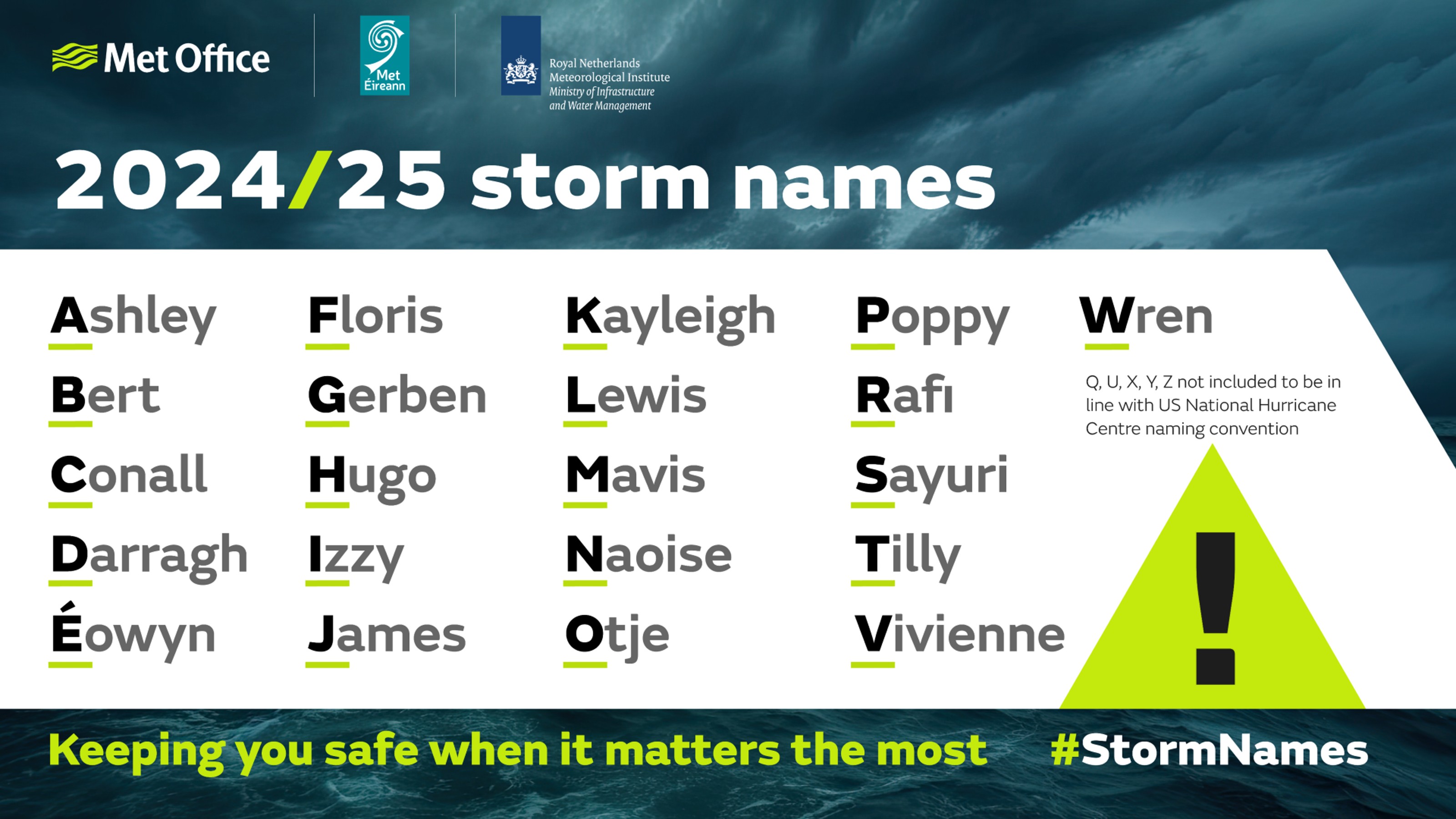
James, Lewis and Mavis have all been included. James is named after Group Captain James Stagg, whose D-Day forecast was critical to the outcome of World War II. Lewis after Lewis Fry Richardson, who devised a theory to use maths and physics to make weather forecasts using computers, and Mavis after Mavis Hinds, who undertook pioneering work on the earliest Met Office computers.
The Met Office, in partnership with Met Éireann and KNMI, have announced the new list of storm names for the 2024/25 season.
- Ashley, Bert and Conall will be the first three named storms by the group this season.
- Met Office contributions to the list include submissions from the public and names of significant people from our 170-year history.
- Naming storms helps to communicate the risks of severe weather.
Storms will get named by the group when they’re deemed to have the potential to cause ‘medium’ or ‘high’ impacts in the UK, Ireland or the Netherlands. Wind is the primary consideration for naming a storm, but additional impacts from rain or snow will also be considered in the naming process.
The Met Office and partners started naming storms in 2015. The list runs from early September to late August the following year to coincide with the start of autumn and the end of summer, when the likelihood of low-pressure systems and the potential for named storms increase.
Met Office Head of Situational Awareness Will Lang, who leads responses in times of severe weather, said: “This is the tenth year of us naming storms and we do it because it works. Naming storms helps to make communication of severe weather easier and provides clarity when people could be impacted by the weather.
“For Storm Babet, which brought exceptional rainfall to parts of eastern Scotland in October 2023, post event surveys suggest 97% of people within the amber and red warning areas were aware of the warnings and 89% of them took action as a result.
“This year, as we celebrate our 170th birthday, it’s great to be able to honour those who have had an impact on our long history of pioneering weather and climate science services.”
The stormy season just gone
The group named 12 storms in the 2023/24 season, reaching the letter ‘L’ with Lilian on 22 August 2024. This is the furthest through the list the Western European naming group has got since storm naming was introduced in 2015.
Will said: “Storm seasons are highly variable in the UK, with some seasons seeing a low frequency of named storms, and others more. One reason there were so many storms last year was the position of the jet stream through much of autumn and winter, which brought a succession of low-pressure systems towards the UK which became named storms.”
Read more about the 2023/24 storm season here.
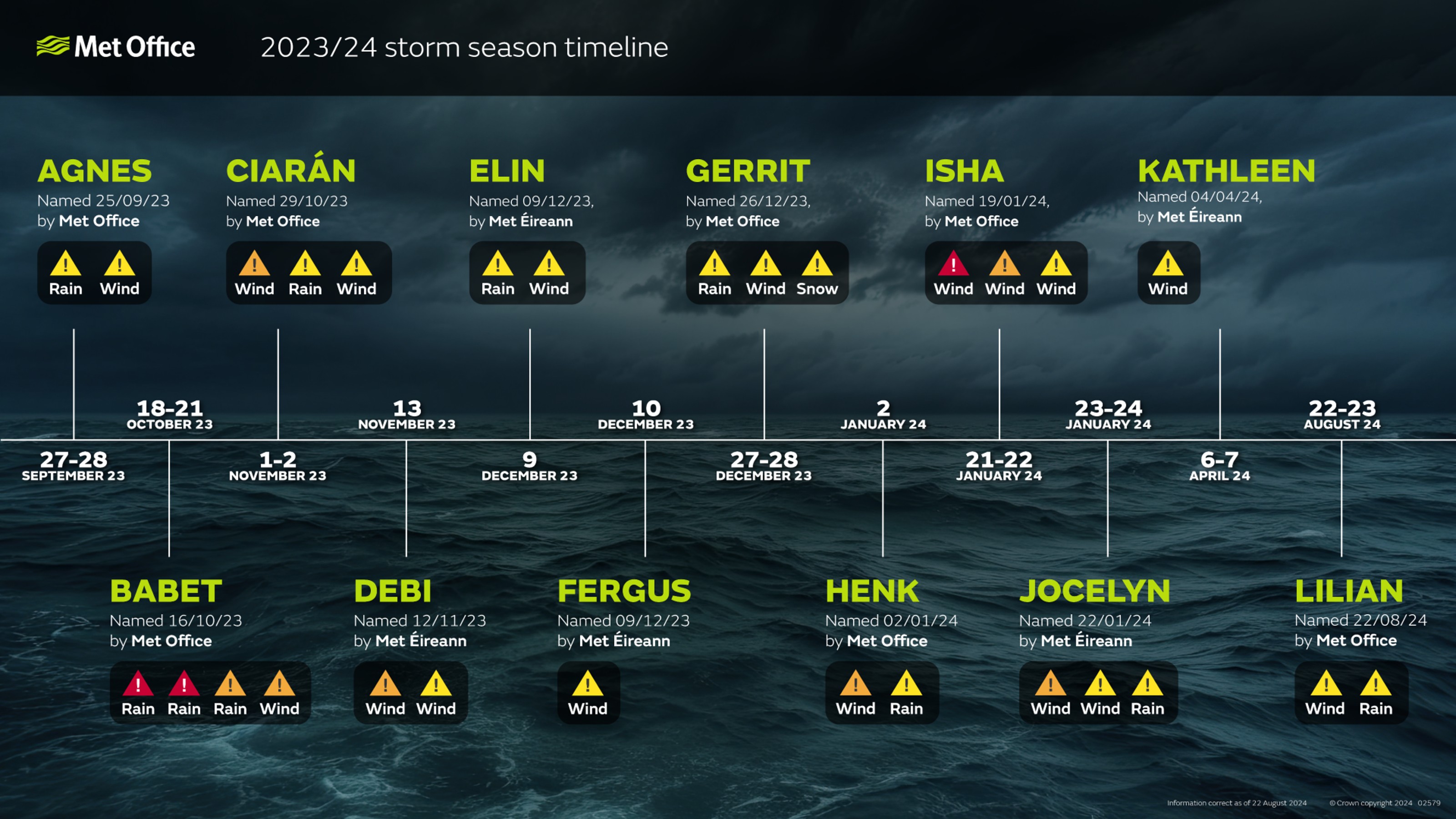
Each year, the Met Office, Met Éireann and KNMI collate the list together. KNMI have chosen names suggested at an environment fair, whereas Met Éireann selected names chosen by children at a STEM event.
Why James?
James is named after Group Captain James Martin Stagg, who was the chief meteorologist responsible for advising General Eisenhower on the weather forecast for the D-Day landings. Stagg and his team forecast poor weather on the 5 of June 1944, which led to Eisenhower postponing the invasion. They also identified the narrow weather window on the 6 of June which allowed the invasion to take place.
Captain James Stagg’s forecast was the most important forecast the Met Office has ever produced.
Read more about Group Captain James Stagg.

Why Lewis?
Lewis is named after Lewis Fry Richardson, who was the first person to work out how to use computers to predict the weather. What’s even more impressive about this feat, is that Richardson devised the theory of Numerical Weather Prediction - producing a forecast by running complex mathematical formulae through a computer - almost 30 years before computers were even invented.
Lewis described how the process could be done using thousands of people who he called “computers”. His description of how they would work together to produce a forecast closely matches how a supercomputer works today.
Read more about Lewis Fry Richardson.
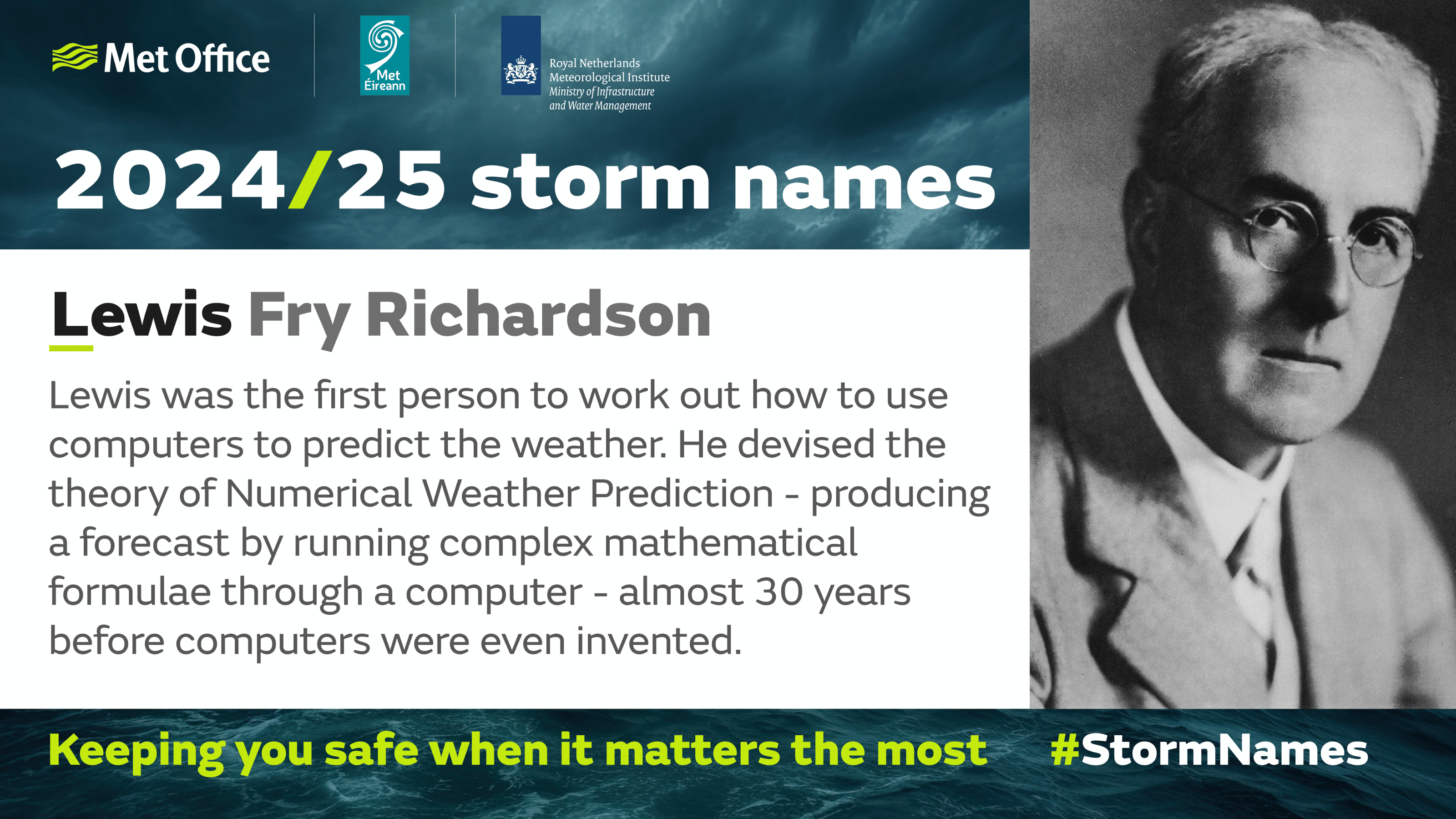
Why Mavis?
Mavis is named after Mavis Hinds. Mavis worked on all the earliest computers used by the Met Office to develop Numerical Weather Prediction from a theory into an operational process.
She started working on the Lyons Electric LEO 1 which was owned by the Lyons catering company, followed by the Ferranti Mark 1 computer at Manchester University. Her team worked on it by night whilst university academics, including Alan Turing, used it during the day.
Her work and that of her team proved that computers could be used to produce fast, accurate weather forecasts, and paved the way for the Met Office to purchase its first computer, which was nicknamed ‘Meteor’. This was then followed by ‘Comet’, which produced the first operational forecast by Numerical Weather Prediction on 2 November 1965.
Read more about the history of numerical weather prediction and early computers here.
Why do storms get named?
Storms are named to aid communication when severe weather is in the forecast. This can help everyone to keep themselves, their property and businesses safe and protected at times of severe weather.
Eoin Sherlock, Head of Forecasting Division in Met Éireann said: “Our key priority is to help protect life and property from extreme weather and ensure the safety of our communities. Year after year storm naming proves effective for that. Naming each storm increases the level of public safety and preparedness as people are more likely to remember and respond to warnings when storms are named.”
KNMI’s Senior Forecaster and Team Manager Jos Diepeveen said: “Naming the storms helps to raise awareness when severe and extreme weather is approaching. Through recognisable names, we hope to reach as many people as possible with our warning before the weather strikes.”
Storm name list in full
Ashley
Bert
Conall
Darragh
Éowyn
Floris
Gerben
Hugo
Izzy
James
Kayleigh
Lewis
Mavis
Naoise
Otje
Poppy
Rafi
Sayuri
Tilly
Vivienne
Wren
Find out more on our UK Storms Centre page
